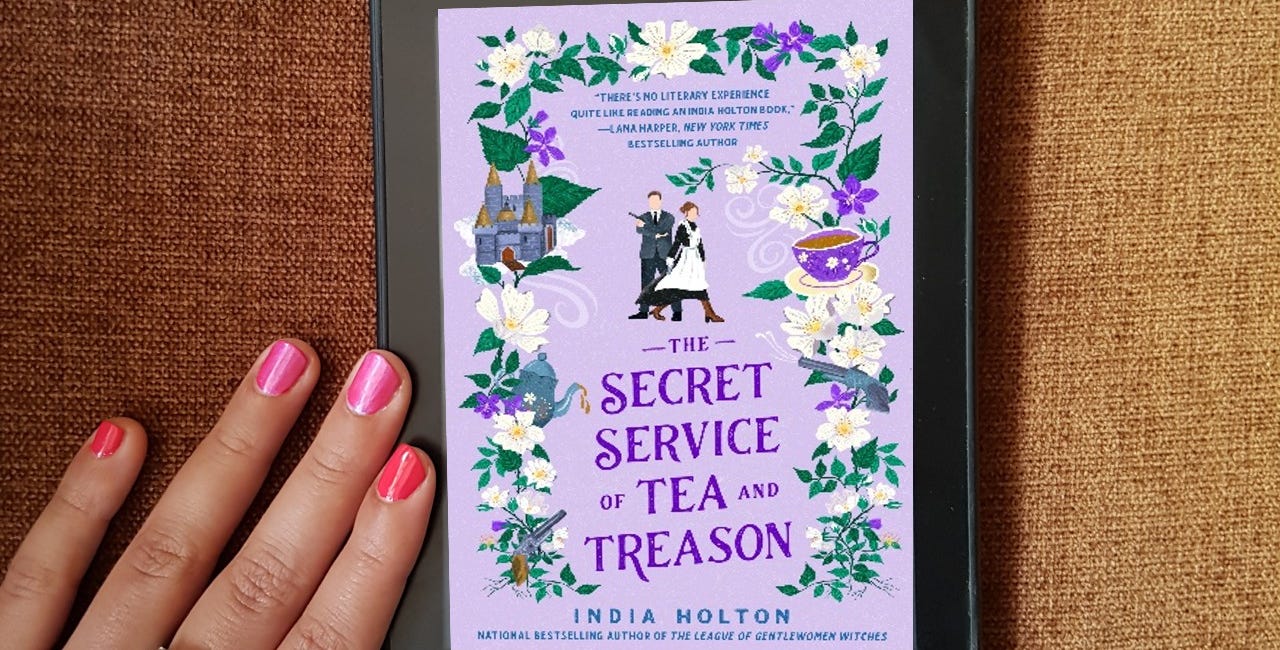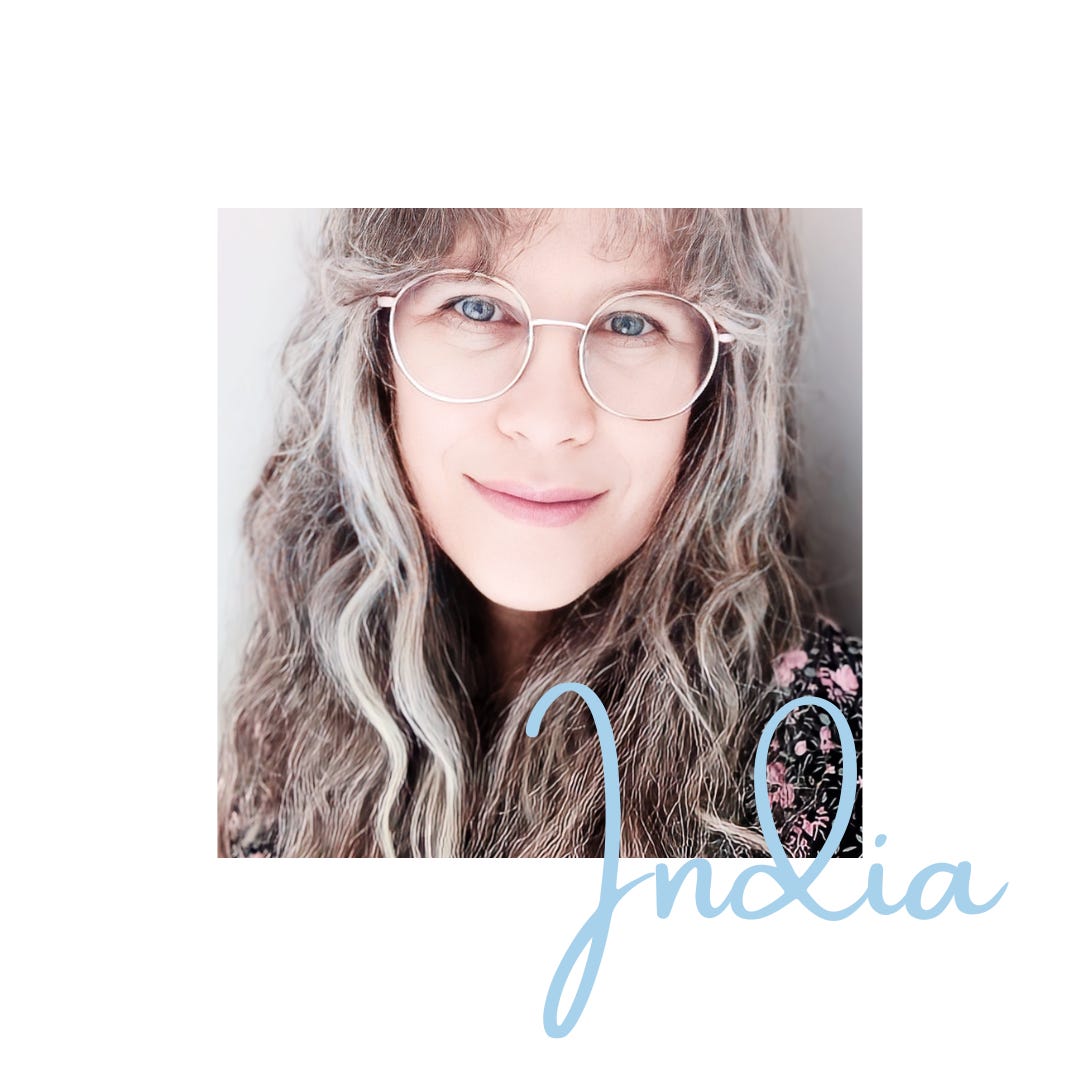Anu Recommends #55
A chat with India Holton about magical birds and romantic hijinks - she is back!
Dear reader,
I’m so excited to finally, properly, gush about one of my favourite reads of the year, and share my chat with the ever-lovely India Holton, but before that some minor admin. The Storyteller will be on a short break, so there won’t be an issue on August 4. I’ll next see you directly on August 11.
Now that that’s out of the way, we can move on to more important topics. such as historical fantasy romcoms reminiscent of Indiana Jones, but with manners, tea, and helicopter parasols, where rival ornithologists hunt through England for a rare magical bird. I happen to be in agreement with Kalyani Saxena, who on NPR, called The Ornithologist’s Field Guide to Love, the first book in a new India Holton series, “so riotously clever it almost defies description.”
But here, regardless, is the publisher’s blurb, which does a good job of summing up the basics:
Beth Pickering is on the verge of finally capturing the rare deathwhistler bird when Professor Devon Lockley swoops in, stealing both her bird and her imagination like a villain. Albeit a handsome and charming villain, but that's beside the point. As someone highly educated in the ruthless discipline of ornithology, Beth knows trouble when she sees it, and she is determined to keep her distance from Devon.
For his part, Devon has never been more smitten than when he first set eyes on Professor Beth Pickering. She's so pretty, so polite, so capable of bringing down a fiery, deadly bird using only her wits. In other words, an angel. Devon understands he must not get close to her, however, since they're professional rivals.
When a competition to become Birder of the Year by capturing an endangered caladrius bird is announced, Beth and Devon are forced to team up to have any chance of winning. Now keeping their distance becomes a question of one bed or two. But they must take the risk, because fowl play is afoot, and they can't trust anyone else—for all may be fair in love and war, but this is ornithology.
I posted this review after pelting through the ARC months ago (shoutout to her publicist, the wonderful Stephanie)—
India Holton has done it again! This is a heartwarming, witty, swoony, soft, fizzy, magical, irreverent light academia historical fantasy romance to kick off a new series titled Love’s Academic. It has all the author’s hallmarks from the Dangerous Damsels series—madcap shenanigans, the wittiest of banter, lots of clever literary references, allusions, and puns, and well-developed, immediately engaging lead characters to wholeheartedly root for—while being more unabashedly frothy and nerdy; a romcom that not just embraces tropes and introduces modern-world elements, but cleverly and cheekily subverts them into a sparkling whole that is perfectly balanced.
Charming, lovable, absurdly bonkers.
A new favourite!
Which is why I’m thrilled to welcome India back to this newsletter today. If you missed out on her first chat with me for the Storyteller last year, you can catch up below:
Anu Recommends #18
Hi and welcome to the Storyteller! Did you enjoy last week’s series spotlight? If not, you can catch up here. Today, on UNESCO World Book and Copyright Day, it’s time for round two of the re-launched edition of this newsletter’s interview series, and I’m delighted to welcome as a guest none other than
The Storyteller’s Creative Chats: India Holton
For those needing a refresher, here is her official bio from her website:
International bestselling author India Holton lives in New Zealand, where she grew up running barefoot around islands, wandering forests, and messing about in boats. Her books are satirical romantic comedies featuring unconventional women and charming rogues. All have been Indie bestsellers, and The Wisteria Society of Lady Scoundrels was a New York Times Notable Book of 2021.
India's writing is fuelled by tea and thunderstorms.
~
Anu: What was your inspiration behind your new Love’s Academic trilogy?
India: I really like the academia aesthetic and also writing characters who are experts, and the two go well together.
Anu: Ornithology in this one, geography in the second—are you allowed to share yet what the third is about? Either way, I’d love to know more about how you picked the first two, and what sort of research it entailed.
India: I can’t share the third yet, but I picked ornithology because bird chasers seemed like a fun concept and I had taught about birds at length in the past. As for geography: I originally planned to write about magical geology, but when I sat down to do the research it overwhelmed me, because I was away from home at the time and had limited internet access to do a comprehensive course of reading. So I switched to an easier subject!
Anu: I’d also love to know what some of your favourite bird facts are that you learned through the course of the book!
India: I mostly called on facts that I knew before, and because the birds in the book are magical, my favourite things about them involve enchantments rather than science!
Anu: This series is also set in late Victorian times, like Dangerous Damsels, but it’s a very different world. How did you go about building this new one, any favourite parts—and what draws you to this particular time period? Would you ever consider writing anything based in contemporary times?
India: I chose the Victorian era again for this new series (actually set a few years after the Dangerous Damsels) for a whole multitude of reasons, such as what academia involved at that time, what women’s lives were like, the lack of cars but the existence of trains, and so on. It was a technical decision, therefore, as it was with my previous series. My favourite part of the world building was creating a private club for academics based on a real one in London. As for writing a novel set in contemporary times—I might do so in the future, but my first love is fantasy, and I prefer writing in an alt historical or otherworld setting, to allow more scope for that.
Anu: Last year when we first spoke prior to the release of Tea and Treason, you mentioned that Field Guide was your most romantic book yet. Now that I’ve read it, I can say that that’s very true! I also found it more overtly rompy and joyful. I’m curious to know the differences in how you approached writing both series—you have a very unique and clear writer’s voice, but the series are very different in tone and vibe.
India: I actually started writing The Ornithologist’s Field Guide to Love before I wrote The League of Gentlewomen Witches, but then put it aside when we decided to stay in the Dangerous Damsels universe. I experience every story as having its own spirit, and I always follow where it takes me. This story had a light, summery, happy spirit.
Anu: What are some of your favourite tropes to write, and some to read about? Are there any you love but haven’t yet had a chance to write about?
India: My favourite tropes to read are enemies to lovers and marriage of convenience (and it’s absolute perfection when they’re together in the same book!). As for writing, I love enemies or rivals to lovers in particular, but of course anyone who has read my books knows that they tend to be tropetastic, because I have a lot of fun playing with what I consider to be the dialect of romance literature.
Anu: Can you talk a bit about the leads of this book? What you enjoyed working on, and if you had any particular troubles with them. Any tips for writing such believable, three-dimensional, and achingly real characters? Each of your characters, even the minor ones, also have a very distinct voice, it’s amazing!
India: Thank you for the kind words. At first Beth was a challenge to write because she’s a good, nice person, and I’d spent years writing quite tough heroines. I wasn’t sure if I could do her justice. But she and Devon have such a sweet dynamic together, it was a joy to write them. I’m afraid I can’t offer any tips for writing characters because, as an autistic person, I don’t really have a good sense of what’s generally considered “realistic”. I just let the characters do what they want, and it works out in the end!
Anu: Are you a plotter, or, as they say, a pantser? Can you share what a typical writing day looks like for you when you’re working on a new project?
India: I plot a basic outline and use “the flashlight method” of knowing in more detail what’s going to happen for the chapter ahead, but otherwise it’s all pantsing. My writing day is very boring considering how many shenanigans, adventures, and exploding teacups I deal with on the page! I do errands and attend to social media until late morning, then after lunch I spend the rest of the day writing.
Anu: Last year I asked you about your favourite non-writing part of the publishing process. Today I’m going to ask you about your favourite writing one 😊.
India: I love editing best of all things. It helps that I have a fabulous editor who always gives great advice.
Anu: Storyteller readers are all ears for your personal favourite recommendations!
India: A couple of recent books that I've loved are What the River Knows by Isabel Ibanez and The Witchwood Knot by Olivia Atwater. Both quite different from each other yet they share the quality of truly masterful writing.
India, thank you so much for making the time for this chat; it’s always a pleasure 💜
You can find her at website | instagram - both of which have buy links for her books.
Please feel free send in recommendations—books, movie, TV shows, authors to interview, ideas of what you’d like me to write on. Let me know what you’re currently reading and watching, send me rants/ramblings/excited monologues, GIFs and memes (especially them) and more. Just drop me a line and turn this into a conversation, even if just to say hi and let me know what you thought of the latest issue. Or share this with someone you think might enjoy it. I always enjoy hearing from you 😊.
Take care and I’ll see you next on August 11!
Anu
You can find me on Twitter at @AnuNande (follow for all the football chatter) and on Instagram at @booksinboston.







Really enjoyed the interview with India Holton. I look forward to every new book of hers . She makes me laugh.